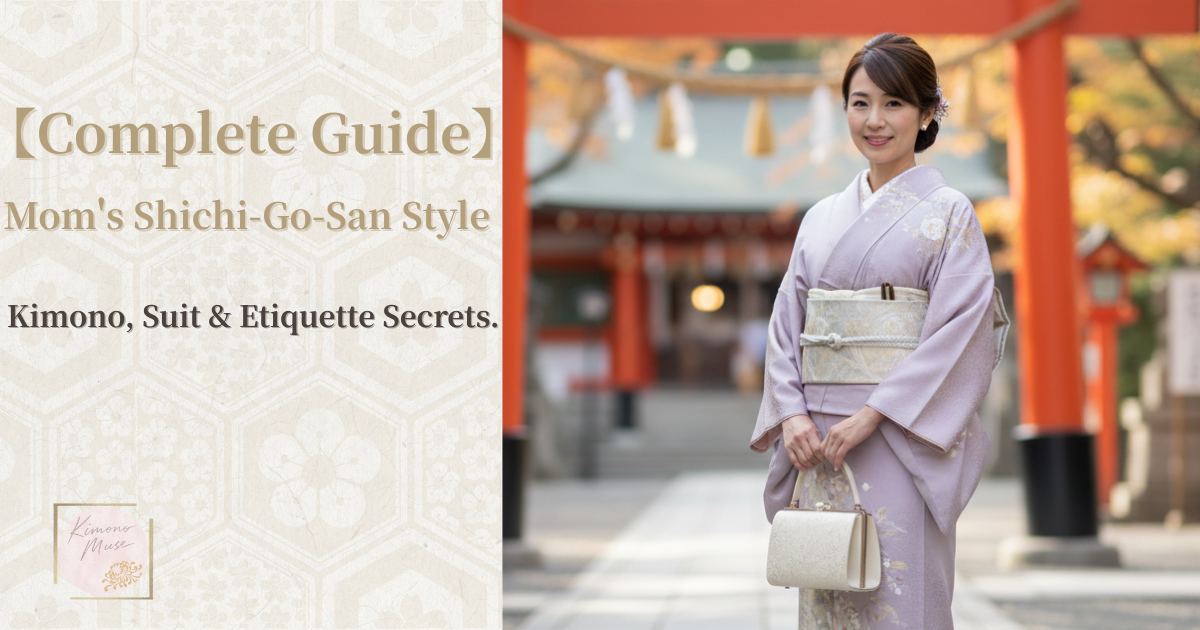For families, Shichi-Go-San is a once-in-a-lifetime milestone. That’s why many mothers may wonder, “What should I wear as the parent on such an important day?”
In this article, we’ve gathered everything you need to know about appropriate attire for mothers at Shichi-Go-San—from etiquette and outfit coordination to preparation tips.
By reading on, you’ll learn the key points when choosing both Japanese and Western styles, as well as the outfits you’ll want to avoid. This guide covers all the basics in one place.
First, the most important point to remember—
The standard is to aim for semi-formal attire (jun-reisō, or semi-ceremonial wear).
The golden rule is never outshine your child, the true star of the day.
When it comes to attire, both kimono and Western-style outfits are perfectly acceptable.
Keep these points in mind, and you’re sure to find the perfect outfit that will make your child—and your whole family—smile on this special day.
Mother’s Attire Etiquette: Understanding Formality and Choosing Colors
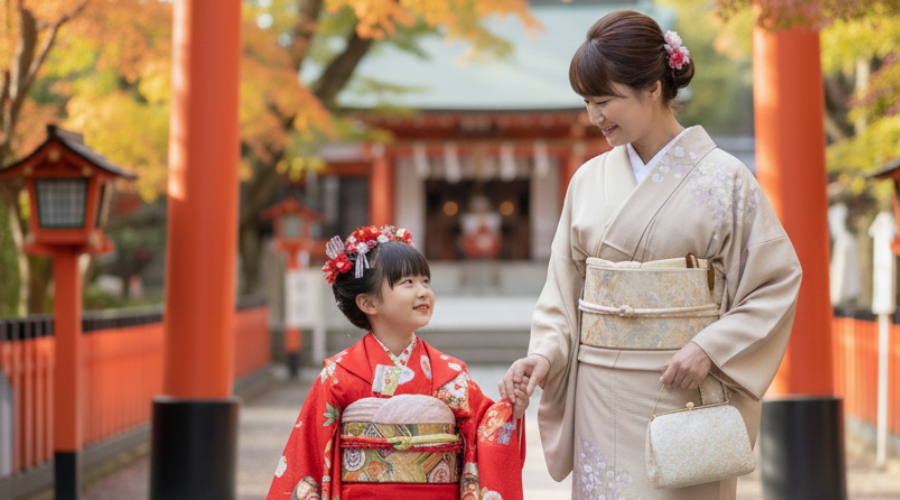
For Shichi-Go-San, the most important thing is that a mother’s outfit complements and highlights her child, who is the true star of the day.
Keep the following basic rules in mind when choosing what to wear.
●Basic Etiquette for Mother’s Attire
| Point | Basic Rule | Specific Notes & Tips |
|---|---|---|
| Level of Formality | Match your child’s level of formality, or choose one step lower. | OK Example: Even if your child wears kimono (haregi, ceremonial dress), the mother can wear semi-formal Western attire such as a suit or one-piece dress without any problem. NG Example: Avoid attire more formal than your child’s. For instance, a black tomesode (the most formal kimono for married women) is more formal than the child’s outfit and should be avoided. |
| Basic Color Choices | Safe options include navy, gray, and beige. | Subdued, classic colors are appropriate in many settings and give a refined impression. |
| Color Coordination | Choose tones that enhance your child’s appearance. | Soft or subdued colors photograph well and make it easier to maintain overall harmony with the family. |
| Notes on Wearing Black | If choosing black, make sure it doesn’t appear too much like mourning attire. | Bright inner layers, pearl accessories, or a corsage can add liveliness and softness to avoid a somber look. |
●Outfits to Avoid and the Reasons
| Outfits / Items to Avoid | Reason |
|---|---|
| Denim, T-shirts, sneakers | Too casual for the formal setting of shrines and temples. |
| Mini skirts, sleeveless tops | Not appropriate for celebratory occasions; they lack refinement and show too much skin. |
| Overly flashy colors, bold patterns, excessive accessories | The focus should remain on your child, the star of the day. A mother’s attire should avoid drawing too much attention. |
●Considerations for Season and Weather
| Point | Basic Rule | Specific Notes & Tips |
|---|---|---|
| Choosing Outerwear | Select a formal coat or haori-style jacket. | Down jackets or casual blousons are not suitable. Materials such as wool or cashmere, with designs that are not overly long, create an elegant impression. |
| Footwear | It’s important to choose shoes that are easy to walk in. | Shrine grounds often have gravel or stone paths. Avoid high heels and instead choose pumps that offer stability. |
Complete Guide to Western Outfits|Recommended Suit and Dress Styles
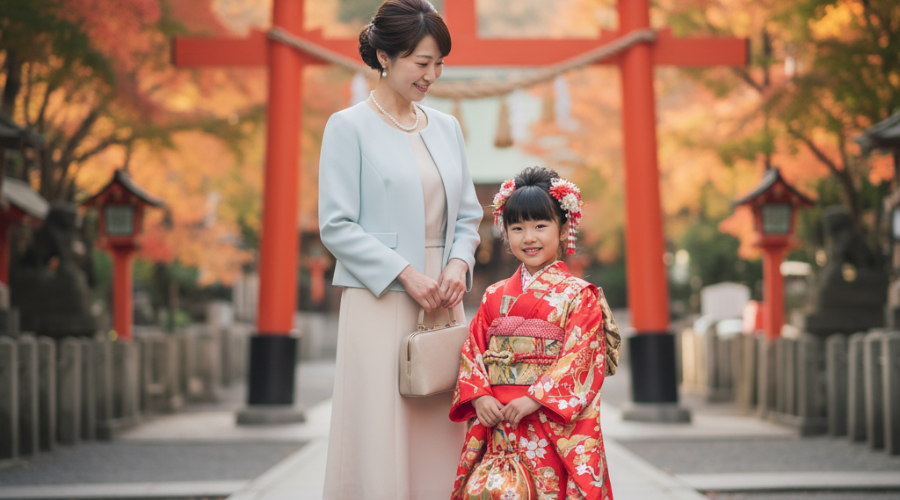
The most commonly chosen semi-formal Western-style outfits for Shichi-Go-San combine ease of movement with elegance, making them a popular choice among mothers of all ages.
●The Timeless Suit Set
Features: The most standard and reliable style for Shichi-Go-San.
Style: Collarless jacket, pencil skirt, peplum, etc.
Colors: Navy / Gray / Beige
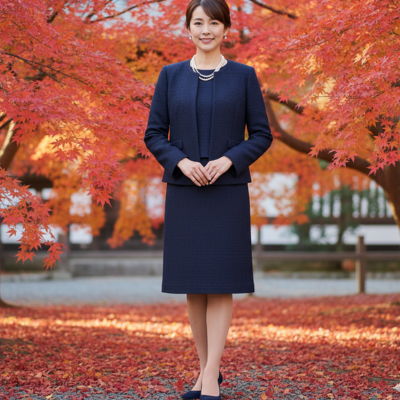
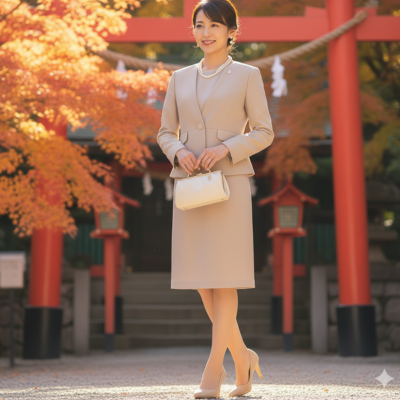
●Refined One-Piece Dress Style
Features: Feminine and elegant.
How to Choose: Below-the-knee length, materials such as tweed or georgette.
Key Point: Adding a jacket enhances the level of formality.
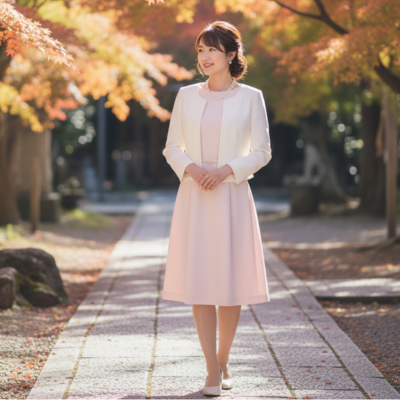
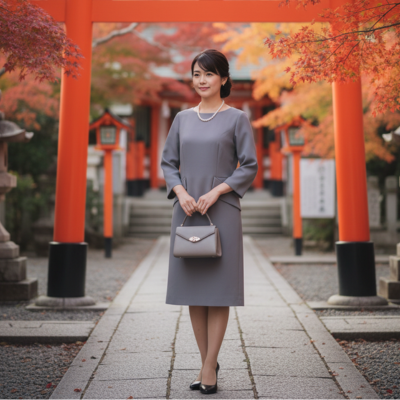
●Comfortable and Stylish Pants Style
Features: Easy to move in, perfect for mothers attending with younger siblings.
Recommended: Tapered pants with a jacket / Jumpsuit with a jacket.
Key Point: Add femininity with accessories or heels.
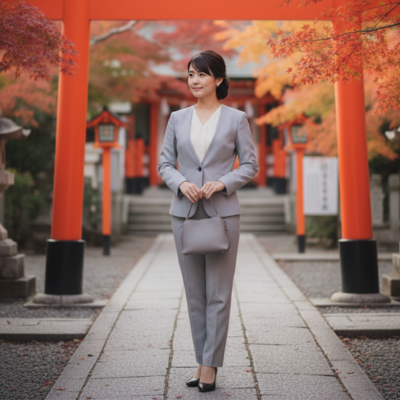
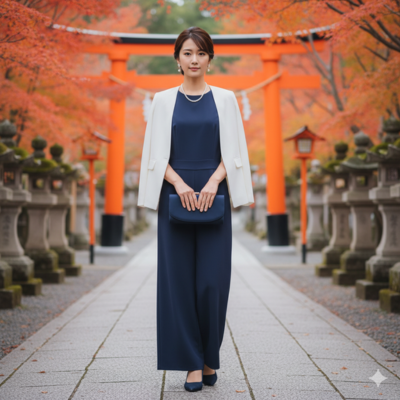
Complete Guide to Kimono|Styles and How to Choose
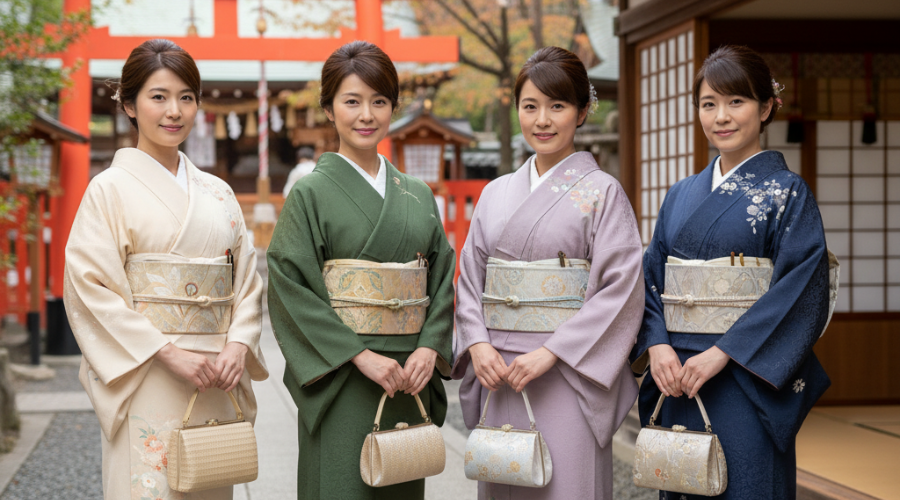
When it comes to Shichi-Go-San, the mother’s kimono is also an important highlight. The basic rule is to choose an outfit that highlights your child while remaining elegant and composed.
If you choose to wear a kimono, opting for homongi, iromuji, or tsukesage—all considered semi-formal styles—will be a safe and appropriate choice.
●Homongi (Visiting Kimono)
The most classic choice for mothers at Shichi-Go-San is the homongi.
Its distinctive feature is the eba-moyo design, where patterns flow seamlessly across the entire kimono like a painting. This style combines both elegance and a sense of celebration.
Features: Semi-formal and versatile, suitable not only for Shichi-Go-San but also for weddings and school entrance or graduation ceremonies.
Color & Pattern Choices: Subdued tones such as wisteria purple, light blue, or beige. Auspicious motifs like pine, bamboo, plum, or cranes are especially popular.
Obi Coordination: Pair with a festive fukuro-obi that includes gold or silver threads to enhance the celebratory mood.
Impression: Photographs beautifully, harmonizes well with children’s kimono, and is a reassuring choice for those wearing kimono for the first time.
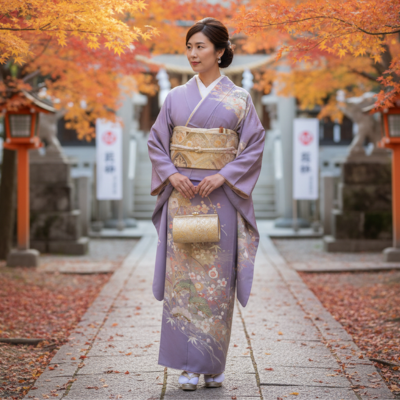
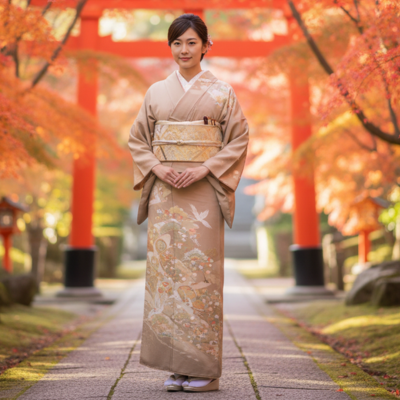
●Iromuji (Plain-Colored Kimono)
An unpatterned kimono dyed in a single color. Adding a family crest (mon) increases its level of formality, making it a safe and appropriate choice for Shichi-Go-San.
Its calm and subdued look allows it to harmonize beautifully when standing alongside grandmothers or other relatives, which is part of its charm.
Features: Its plain design makes it easy to change the overall look with different obi and accessories.
Color Choices: Calm tones such as wisteria purple, light green, or soft gray are recommended.
Obi Coordination: Pair with a fukuro-obi or an elegant nagoya-obi to add a touch of festivity.
Impression: Subtle yet refined, serving to highlight the child’s celebratory attire in photos.
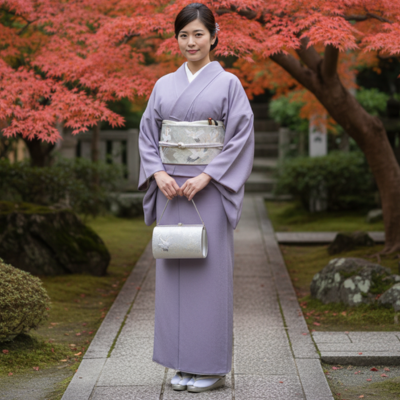
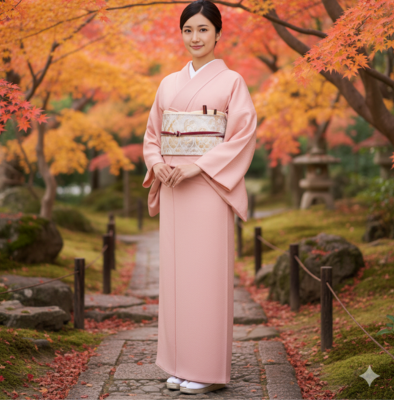
●Tsukesage (Subtle Patterned Kimono)
More understated than the homongi, the tsukesage features patterns placed modestly, often rising upward from the shoulders or hem.
For Shichi-Go-San, it is a popular choice among mothers who prefer “elegance without being overly showy.”
Features: Less showy than the homongi, yet offering more variation than the plain iromuji.
Color & Pattern Choices: Subdued shades such as pale blue, soft pink, or gray, with modest motifs like small flowers or flowing water.
Obi Coordination: The basic rule is to pair it with a fukuro-obi to maintain proper formality.
Impression: Creates an elegant and composed atmosphere, modest yet photogenic.
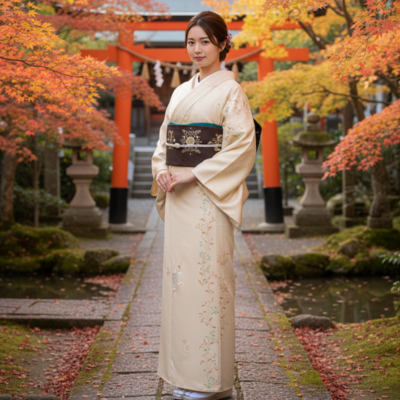
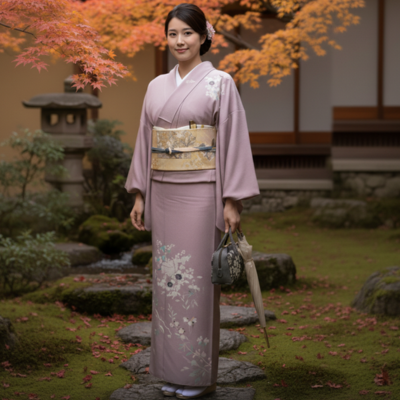
Choosing Accessories to Complete Your Look
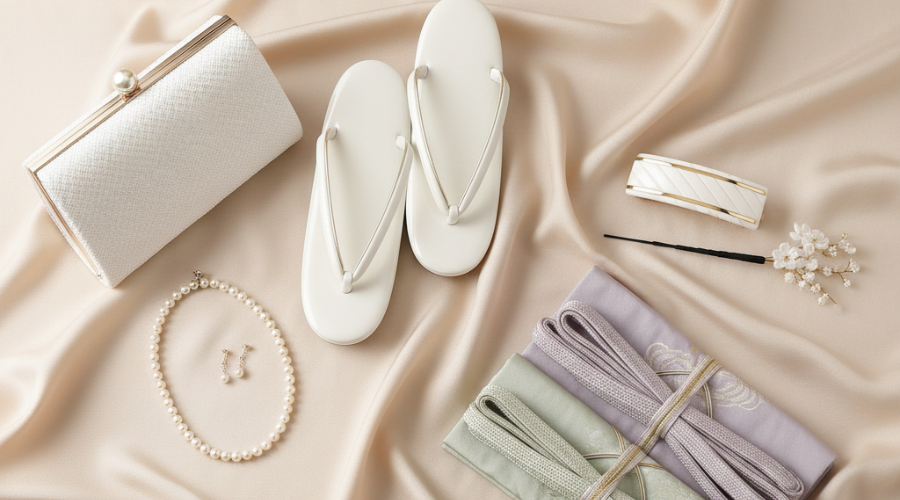
The overall impression can change dramatically depending on how you choose your bag, shoes, accessories, and hair ornaments.
To ensure your look remains appropriate for the shrine setting, let’s review in the table below how mothers can select refined accessories that are suitable for Shichi-Go-San.
| Item | Basic Rule | Notes & Recommendations |
|---|---|---|
| Bag | A small, elegant handbag | Avoid black or overly flashy designs. Beige or light colors are a safe choice. |
| Shoes | Pumps (3–5 cm heel) | Sandals and boots are not suitable. Comfort for walking is also important. |
| Accessories | Pearls or simple jewelry | Avoid pieces that are too large or excessive. Keep the look refined. |
| Hair Ornaments | Subtle barrettes or combs | Be mindful not to appear more glamorous than your child. |
Q&A: Current Etiquette and Style Trends
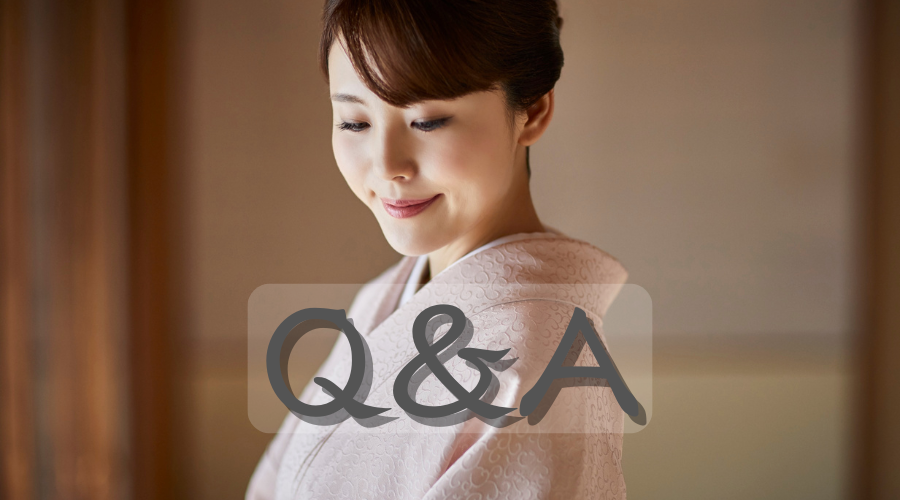
**Q. How should a mother coordinate her outfit with the father’s?**
A. For fathers, a dark-colored suit is the standard. Even if the mother wears kimono, the father can still wear a suit without issue. Matching the overall tone between the two creates a more harmonious look in photos.
**Q. Should a mother’s outfit change depending on the child’s age?**
A. There are no strict rules. However, at age three, mobility is key since mothers are often busy caring for the child. At ages five and seven, it is safe to lean slightly more toward formality.
**Q. What about grandparents’ attire?**
A. For grandmothers, subdued outfits such as an iromuji kimono or a modest suit are appropriate. For grandfathers, a dark suit is the standard. Calm, understated attire that highlights the child as the star is preferred.
**Q. How should mothers dress for warmth in colder seasons?**
A. For Western-style outfits, coats or shawls are common. For kimono, layering a michiyuki coat or a shawl is standard. Using thermal innerwear such as Heattech is also recommended, as it provides warmth without disturbing the overall appearance.
**Q. Should corsages be worn with Western outfits?**
A. A corsage is not mandatory, but it is often recommended as a festive touch for celebratory occasions. Choose subtle colors such as beige or off-white, and coordinate it with the tone of your suit or dress for a refined look.
**Q. Should all-black outfits be avoided?**
A. Yes. An entirely black outfit can evoke associations with mourning, which is unsuitable for a celebratory event. If wearing a black suit, balance it with light-colored accents such as a blouse, handbag, or corsage in beige, white, or pale pink to add a festive touch.
Conclusion
Shichi-Go-San is a precious celebration of your child’s healthy growth and development.
For mothers, the golden rule is simply to choose an outfit that “elegantly highlights your child, the true star of the day, while remaining refined and composed.” As long as you follow this principle, you’ll be just fine.
Whether you opt for Western attire such as a suit or dress, or kimono styles like homongi or iromuji with a touch of understated elegance, both are perfectly suitable.
The etiquette we’ve shared here is all about ensuring that your child’s special day is celebrated in comfort and joy.
Above all, what truly matters is not a flawless outfit, but cherishing and enjoying the time spent together as a family.
Choose attire that feels natural to your lifestyle and the season, without forcing yourself. Stand proudly by your child, showing your warmest smile.
Those heartfelt memories will surely become the most beautiful treasures of all.
✿ Column: Fumi’s Kimono Diary ✿
When we think of Shichi-Go-San, the main celebration in November usually comes to mind. But in recent years, more and more families are choosing to do maedori—pre-shooting their commemorative photos.
At a photo studio, everything from outfits to hair and makeup is provided, making it comfortable and easy for children. Unlike the busy day of the actual ceremony, the whole family can relax and enjoy the photo session, which is a wonderful advantage.
On the other hand, “location photography” at shrines, gardens, or parks is also becoming increasingly popular. Photos taken in natural light capture softer expressions, and when autumn leaves or greenery appear in the background, the images feel even more seasonal.
I also found that the kimono of mothers and grandmothers looks especially beautiful in outdoor light, offering a different charm from studio photos.
Shichi-Go-San is not only about the photos themselves, but also about cherishing the time spent taking them. Whether at a studio or outdoors, leaving behind a picture that feels true to your family makes for a truly special memory.
